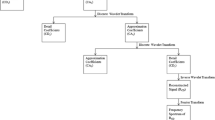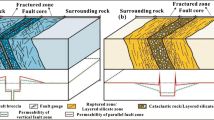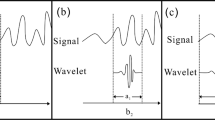Abstract
Identification of sharp and discontinuous lithological boundaries from well log signal stemming from heterogeneous subsurface structures assumes a special significance in geo-exploration studies. Well log data acquired from various geological settings generally display nonstationary/nonlinear characteristics with varying wavelengths and frequencies. Modelling of such complex well-log signals using the conventional signal processing techniques either fails to catch-up abrupt boundaries or at the best, do not provide precise information on insidious lithological discontinuities. In this paper, we have proposed a new wavelet transform-based algorithm to model the abrupt discontinuous changes from well log data by taking care of nonstationary characteristics of the signal. Prior to applying the algorithm on the geophysical well data, we analyzed the distribution of wavelet coefficients using synthetic signal generated by the first order nonstationary auto-regressive model and then applied the method on actual well log dataset obtained from the KTB bore hole, Germany. Besides identifying the formation of layered boundaries, the underlying method also maps some additional formation boundaries, which were hitherto undetected at the KTB site. The results match well with known geological lithostratigraphy and will be useful for constraining the future model of KTB bore hole data.











Similar content being viewed by others
References
Adamowski J and Chan H F 2011 A Wavelet neural network conjunction model for groundwater level forecasting ; J. Hydrol. 407 28–40.
Alvarez G, Sanso B, Michelena R J and Jimenez J R 2003 Lithologic charecterizations of a reservoir using continuous wavelet transform; IEEE Trans. Geosci. Remote Sens. 41 (1) 59–65, doi: 10.1109/TGRS.2002.808065.
Boggess A and Narcowich F J 2001 A First Course in Wavelets with Fourier Analysis; Prentice-Hall, Englewood Cliffs, NJ, 283p.
Bosch D, Ledo J and Queralt P 2013 Fuzzy logic determination of lithologies from well log data: Application to the KTB project data set; Surv. Geophys. 34 413–439, doi: 10.1007/s10712-013-9242-2.
Chandrashekhar E and Rao V E 2012 Wavelet analysis of geophysical well-log data of Bombay offshore basin, India; Math. Geosci. 44 901–928.
Chamoli A, Bansal A R and Dimri V P 2007 Wavelet and range approach for the Hurst coefficient for short and long time series; Comput. Geosci. 33 83–93.
Chamoli A, Swaroopa R., Srivastava K, Srinagesh D and Dimri V P 2010 Wavelet analysis of the seismograms for tsunami warning; Nonlin. Process. Geophys. 17 569–574.
Daubechies I 1992 Ten Lectures on Wavelets; Soc. for Ind. Appl. Math., Philadelphia, Pa, 357p.
Dewan J T 1983 Essentials of Modern Open-Hole Log Interpretation; PennWell Publishing Company, Tulsa, US, 361p.
Doveton J. 1986 Log Analysis of Subsurface Geology Concepts and Computer Methods; Wiley, New York, NY, 273p.
Emmermann R and Lauterjung J 1997 The German continental deep drilling program KTB: Overview and major results; J. Geophys. Res. 102 18,179–18,201.
Frantziskonis G and Denis A 2003 Complementary entropy and wavelet analysis of drilling-ability data; Math. Geol. 35 (1) 89–103.
Goumas S K, Zervakis M E and Stavrakakis G S 2002 Classification of washing machines vibration signals using discrete wavelet analysis for feature extraction; IEEE Trans. Instr. Meas. 51 (3) 497–508.
Goupillaud R A, Grossmann A and Morlet J 1985 Cycle-octave and related transform in seismic signal analysis; Geoexploration 23 85–102.
Hsieh B Z, Lewis C and Lin Z S 2005 Lithology identification of aquifers from geophysical well logs and fuzzy logic analysis: Shui-Lin Area, Taiwan; Comput. Geosci. 31 263–275.
Jang J S R and Jang Y S 2003 Microcontroller implementation of melody recognition: A prototype; Proceedings of the 11th ACM International Conference on Multimedia, Berkeley, CA, USA, pp. 452–453.
Javid M and Tokhmechi B 2012 Formation interface detection using gamma ray log: A novel approach; J. Mining & Environment 3 (1) 41–50.
Kumar P and Foufoula-Georgiou E 1997 Wavelet analysis for geophysical applications; Rev. Geophys. 35 (4) 385–412, doi: 10.1029/97RG00427.
Lanning E N and Johnson D M 1983 Automated identification of rock boundaries: An application of the Walsh transform to geophysical well-log analysis; Geophysics 48 197–205.
Lau K M and Weng H 1995 Climate signal detection using wavelet transform: How to make a time series sing; Bull. Am. Meteor. Soc. 76 2391–2402.
Leonardi S and Kumpel H 1999 Fractal variability in super deep borehole implications for the signature of crustal heterogeneities; Tectonophys. 301 173–181.
Leung A K, Chau F and Gao J 1998 A review on application of wavelet transform techniques in chemical analysis; Chemometrics and Intelligent Laboratory Systems 43 165–184.
Liu Z, Zhou P, Chen G and Guo L 2014 Evaluating a coupled discrete wavelet transform and support vector regression for daily and monthly stream flow forecasting; J. Hydrol. 519 2822–2831.
Maiti S and Tiwari R K 2005 Automatic detection of lithologic boundaries using the Walsh transform: A case study from the KTB borehole; Comput. Geosci. 31 (8) 949–955.
Maiti S and Tiwari R K 2010 Neural network modelling and an uncertainty analysis in Bayesian framework: A case study from the KTB borehole site; J. Geophys. Res. 115 B10208, doi: 10.1029/2010JB000864.
Maiti S, Tiwari R K and Hans-Joachim K. 2007 Neural network modeling and classification of litho-facies using well log data: A case study from KTB borehole site; Geophys. J. Int. 169 733–746, doi: 10.1111/j.1365-246X.2007.03342.x.
Mallat S G 1989 A theory for multi-resolution signal decomposition: The wavelet representation; IEEE Trans. Pattern Analysis and Mach. Intelligence 11 (7) 674–693, doi: 10.1109/34.192463.
Maraun D, Kurths J and Holschneider M 2007 Nonstationary Gaussian processes in wavelet domain: Synthesis, estimation, and significance testing; Phys. Rev. E 75 016707.
Misti M, Misti Y, Oppenheim G and Poggi J M 2007 Wavelet Toolbox 4 for Use with MATLAB User’s Guide; The Math Works Inc., Natick, M.A., USA , pp. 1–1170.
Morlet J, Arens G, Fourgeau E and Giard D 1982 Wave propagation and sampling theory. Part I: Complex signal and scattering in multilayered media; Geophysics 47 (2) 203–221.
Oppenheim A V, Schafer R W and Buck J R 1999 Discrete-Time Signal Processing; Prentice-Hall, Englewood Cliffs, NJ, 879p.
Pan S, Hsieh B, Lu M and Lin Z 2008 Identification of stratigraphic formation interfaces using wavelet and Fourier transform; Comput. Geosci. 34 77–92.
Percival D B 2008 Analysis of geophysical time series using discrete wavelet transforms: An overview; In: Nonlinear Time Series Analysis in the Geosciences – Applications in Climatology, Geodynamics, and Solar-terrestrial Physics (eds) Donner R V and Barbosa S M, Springer, Berlin/Heidelberg.
Pechnig P, Haverkamp S, Wohlenberg J, Zimmermann G and Burkhardt H 1997 Integrated interpretation in the German Continental Deep Drilling Program: Lithology, porosity, and fracture zones; J. Geophys. Res. 102 18,363–18,390.
Perez-Munoz T, Velasco-Hernandez J and HernandezMartinez E 2013 Wavelet transform analysis for lithological characteristics identification in siliciclastic oil fields; J. Appl. Geophys. 98 298–308.
Sang Y F, Wang Z and Liu C 2013 Discrete wavelet-based trend identification in hydrologic time series; Hydrol. Process. 27 2021–2031.
Seo Y, Kim S, Kisi O and Singh V P 2015 Daily water level forecasting using wavelet decomposition and artificial intelligence techniques; J. Hydrol. 520 224– 243.
Soliman M Y, Ansah J, Stephenson S and Mandal B 2003 Application of wavelet transform to the analysis of pressure-transient data; SPE Reservoir Eval. Eng. 6 (2) 89–99.
Wickerhauser M V 1994 Adapted Wavelet Analysis from Theory to Software; A K Peters, Wellesle, MA, USA, 486p.
Acknowledgements
We are thankful to Prof. D C Panigrahi, Director, Indian School of Mines, Dhanbad, for giving permission to publish this work and also thankful to Head of the Department, Applied Geophysics. One of the authors, Amrita Singh, is grateful to Indian School of Mines, Dhanbad for providing junior research fellowship to carry out the research work. We are also thankful to Prof. Hans-Joachim Kumpel for providing the KTB data. We sincerely thank the anonymous reviewers who have helped us to improve the manuscript in many interesting ways. Partial financial benefit from the Ministry of Earth Sciences, Govt. of India, New Delhi, India, is also thankfully acknowledged (Grant No: MoES/P.O. (Geosci)/44/2015).
Author information
Authors and Affiliations
Corresponding author
Additional information
Corresponding editor: Pawan Dewangan
Rights and permissions
About this article
Cite this article
Singh, A., Maiti, S. & Tiwari, R.K. Modelling discontinuous well log signal to identify lithological boundaries via wavelet analysis: An example from KTB borehole data. J Earth Syst Sci 125, 761–776 (2016). https://doi.org/10.1007/s12040-016-0701-2
Received:
Revised:
Accepted:
Published:
Issue Date:
DOI: https://doi.org/10.1007/s12040-016-0701-2




